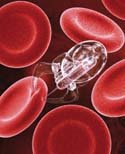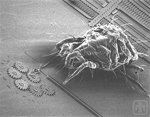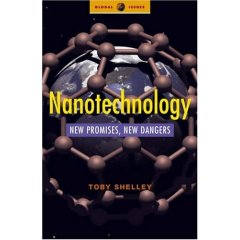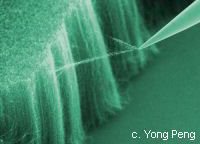Nanoethics Group's anthology covers near- and long-term societal impacts of nanotech
August 3, 2007
Small Times
The Nanoethics Group has released a collection of papers that it says is the first to address both urgent and distant issues related to nanotechnology's impact on society. Published by John Wiley & Sons, the 416-page anthology includes papers from nearly 40 contributors worldwide including Mihail Roco (US NSF) and Ray Kurzweil (Kurzweil Technologies.
Titled Nanoethics: The Ethical and Social Implications of Nanotechnology it tackles a full range of issues facing nanotechnology, such as those related to: benefits, risk, environment, health, human enhancement, privacy, military, democracy, education, humanitarianism, molecular manufacturing, space exploration, artificial intelligence, life extension, and more. The anthology also reprints seminal articles, such as Bill Joy's "Why The Future Doesn't Need Us" that already had sparked much debate.
The paperback version is priced at $39.95 to encourage university and broader adoption as a way to further public discourse in nanoethics. (for sale on Amazon for £22.00.)
Oncor deters copper wire theft with nanotechnology
August 3, 2007
Small Times
Oncor Electric Delivery, a business that provides power to more than three million homes and businesses in
The technology marks Oncor equipment and particularly copper wire so that it can be identified after it has been stolen. Oncor says it will work closely with law enforcement in this effort. Areas protected with the technology will also have signs warning that material has been marked with a traceable technology.
"This is a traceable technology that will enable us to not only identify our stolen goods, but also to prosecute to the fullest extent of the law," said Rob Trimble, president and chief operating officer of Oncor. "Substations and switchyards have been the main targets for copper theft. Thieves are literally taking their lives in their hands for some spending money when they remove metal from a high-voltage area."
Not only is safety an issue for thieves, but also for Oncor employees. When protective ground wires are stolen from substations and switchyards, employees may be shocked or injured.
Nano-Proprietary, Mitsui extend relationship for carbon nanotube lighting
July 31, 2007
Small Times
Nano-Proprietary Inc., (NPI) through its subsidiaryApplied Nanotech Inc., announced that
Mitsui reports "remarkable progress" in its discussions with at least five leading companies and says it expects one or more of these companies to be interested in a license. The purpose of the extension is to continue the prospecting process and try to finalize license agreement under the exclusive option agreement. In addition, as a result of the successful collaboration in
Mitsui has various future extension rights, at escalating fee levels, to maintain the right to grant licenses.
CEA/Leti-Minatec and Alcatel to co-develop 3D interconnect processes
July 24, 2007
Small Times
CEA/Leti-Minatec, a European R&D institute specializing in advanced microelectronics, and Alcatel Micro Machining systems, manufacturer of deep reactive ion etch (DRIE) equipment for the MEMS and semiconductor industries, will collaborate to develop industrial process capability in DRIE and LTPECVD for 3D interconnect applications. The collaboration addresses the trend that advanced packaging technologies and chip stacking techniques play an increasing role in the evolution of microelectronics and microsystems.
CEA Leti-Minatec intends to expand its capabilities in 3D integration to include thru-wafer micro vias to allow dense interconnect on both sides of chips. Considering the importance of deep anisotropic etching of silicon and via isolation to the success of the technology, CEA-Leti Minatec will accelerate development by joining efforts with Alcatel Micro Machining Systems, which it calls the world leader in DRIE equipment. The two-year program leverages capabilities made possible by the installation of two new 200mm Alcatel machines for DRIE of silicon and LTPECVD of low temperature oxide isolation. The partners expect to develop and demonstrate a suite of turn-key solutions for integration in advanced electronic systems.
Business Briefs
27 July 2007
Nanotechweb.org
Industrial NanoTech reports that its Nansulate LDX coating is being applied at a Pacific US Navy facility by a military contractor to encapsulate existing lead-based paint. The firm explains that its environmentally safe, water-based, lead abatement coating can be applied to any substrate, forming a barrier coat to seal highly toxic lead paints.
An initiative to develop a "Responsible NanoCode" for businesses working with nanotechnologies has been launched by the Royal Society, Insight Investment, the Nanotechnology Industries Association and the Nanotechnology Knowledge Transfer Network. Confirmed members of the working group so far include – amongst others – BASF, Unilever, Smith & Nephew, the consumer group Which?, development NGO Practical Action, and Amicus.
Company news
Carl Zeiss SMT has acquired 100% of the shares of ALIS Corporation,
Raith GmbH has been developing and selling high-tech systems in the domain of nanotechnology worldwide.
Latest News
Raith User Meeting
Next User Meeting will be held on 20th September 2005 at the "MNE 2005" taking place from 19th to 22nd September in
Raith Training Courses
LTC-I: EBL Basics and Software Training date: June 7th - 9th, 2005
LTC-II: User Workshop and Advanced Topics date: June 28th - 30th, 2005
For further information please see Raith website
Product categories
- Etching & lithography equipment
- Microscopy
- Software
26.07.2007
TNTlog
Nanotechnology consortium to be created in
ALMATY. July 26. KAZINFORM /Aigul Turysbekova/ - Education and Science Minister of Kazakhstan Zhanseit Tuimebayev is going to meet with Zhores Alfyorov, the vice president of the Russian Academy of Sciences, Nobel laureate and the leading Russian scientists on July 27 in Almaty.
The main purpose of the visit of the Russian scientists to
During the meeting, Zhanseit Tuimebayev and Zhores Alfyorov will sign a Memorandum on creation of the scientific-educational innovation consortium Nanotechnology in
From IPO's to Fire Sales
Tim Harper
What a number of investors didn’t want me to mention is that nanotech companies are falling like ninepins at the moment. As an example, this announcement from API Nanotronics fails to mention that NanoOpto closed the doors some time ago, pretty much around the time that they were mentioned as a possible IPO candidate in the ForbesWolfe report report. Rumour is that the assets went for a million or two which is hardly a great return on the $60 million invested.
Rather than a bunch of IPO’s we may see another raft of closures this year as investors lose patience, companies fail to make that big sales or technical breakthough, and the assets are stripped out. I have seen a number of ‘nanotech’ companies that simply shouldn’t exist as a corporate entity, fear and greed meant that they were spun out of the lab way too fast, and after a few years spent generating and protecting intellectual property, many are finding IP no substitute for a product that generates revenues.






